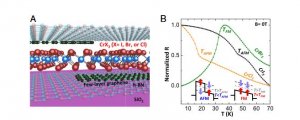Summary
Two-dimensional (2D) layers just one atom thick can be stripped from certain materials, such as graphene. The individual layers from one or more of these materials can then be restacked to create cage-like quantum heterostructures, which possess novel quantum properties. Incorporating magnetism into such a structure at room temperature could enable direct control of electron spin polarization in the transistor geometry. We are working to combine 2D semiconductors and magnetic insulators as an early step toward creation of magnetic semiconductor heterostructures for spintronic devices. Along with proving the heterostructure concept, success in combining the two materials supports a subsequent goal, fabrication of a nanostructure consisting of a superconductor, semiconductor, and magnetic insulator. Achievement of these two goals will provide a fundamental building block for spintronics, address a vital materials challenge in the pathway to quantum computing, and potentially allow for integration of processing and storage technologies in a single device platform.

Figure 1. Magnetic van der Waals tunnel junction incorporating ultrathin chromium trihalides. (A) Schematic illustration of the device. (B) Normalizedtemperature-dependent dc resistance of CrX3(X=I, Br, and Cl) at constant current of 0.1 nA.Insetsshow schematics of the spin-dependent tunnel barrier forAFM and FM interlayer coupling. Red and blue arrows indicate spin orientation and are used throughout. Original illustration from PNAS Publications.
Related Content
Fabrication of Ultra Low Noise RF SQUID Amplifiers
A superconducting quantum interference device (SQUID) is an extremely sensitive magnetic field detector.
June 1, 2017

Magnetoelectric Coupling in New Composite Multiferroic Nanostructures as High-Density Quantum Multistate Memory Elements
Summary Magnetoelectric multiferroics are materials that exhibit correlated ferroelectric and ferromagnetic properties (i.e., a magnetoelectric effect). The resulting ability of these materials to simultaneously store data in electric polarization and magnetic moment could increase data storage density and data processing speed while reducing energy consumption. This project aims to design and fabricate new composite multiferroic […]
February 1, 2023
Using Interactive Digital Storytelling to Represent Transformative Quantum Technologies in Augmented/Extended Reality Environments
Summary A major roadblock to the broader adoption of quantum technologies is the long learning curve associated with their seemingly abstract concepts. This often renders quantum technologies inaccessible to most audiences, especially through explanations using conventional scientific language. In this project, we develop novel methods of interactive digital storytelling – augmented and extended reality (AR/XR) […]
February 24, 2021

Entangled Photon Orbital Angular Momentum Arrays
Summary Arrays of orbital angular momentum (OAM) states of light are a new form of structured light so far relatively unexplored in quantum information science. Unlike spin angular momentum of light, which is related to light’s polarization and covers two dimensions, OAM states, sometimes described as ‘donut beams’ due to the shape of the field […]
September 19, 2019

